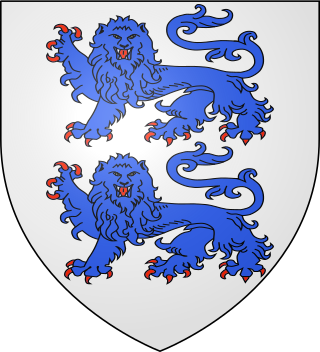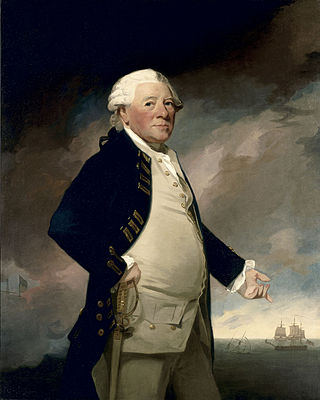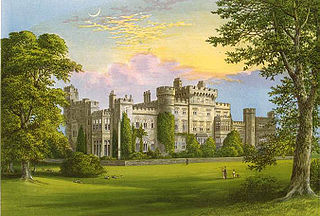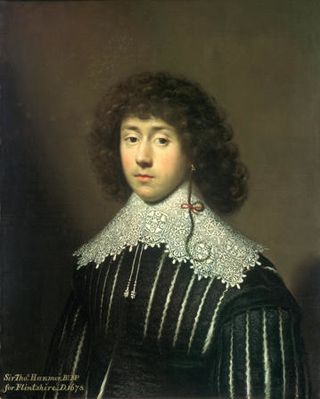Related Research Articles

Earl of Buckinghamshire is a title in the Peerage of Great Britain. It was created in 1746 for John Hobart, 1st Baron Hobart.

Earl of Romney is a title that has been created twice.

Earl of Cottenham, of Cottenham in the County of Cambridge, is a title in the Peerage of the United Kingdom. It was created in 1850 for the prominent lawyer and Whig politician Charles Pepys, 1st Baron Cottenham. ) He served as Lord Chancellor from 1836 to 1841 and from 1846 to 1850. Pepys had already been created Baron Cottenham, of Cottenham in the County of Cambridge, in 1836, and was made Viscount Crowhurst, of Crowhurst in the County of Surrey, at the same time he was given the earldom. These titles are also in the Peerage of the United Kingdom. The viscountcy is used as a courtesy title for the Earl's eldest son and heir apparent.

Baron Stanley of Alderley, in the County of Chester, is a title in the Peerage of the United Kingdom. It was created in 1839 for the politician and landowner Sir John Stanley, 7th Baronet.
Baron Mostyn, of Mostyn in the County of Flint, is a title in the Peerage of the United Kingdom. It was created in 1831 for Sir Edward Lloyd, 2nd Baronet, who had earlier represented Flint Boroughs and Beaumaris in the House of Commons. His son, the second Baron, sat as a Member of Parliament for Flintshire and Lichfield and served as Lord Lieutenant of Merionethshire.

There have been two baronetcies created for members of the Hanmer family of Flintshire, Wales, one in the Baronetage of England and one in the Baronetage of Great Britain. Only one creation is extant as of 2008. The third Baronet of the second creation was elevated to the peerage as Baron Hanmer in 1872, a title which became extinct in 1881. The family name derived from the manor of Hanmer in the Diocese of St. Asaph.
There have been two baronetcies created for people with the surname Heathcote, both in the Baronetage of Great Britain and both created in 1733. The holders of the first creation were later elevated to the peerage as Baron Aveland and Earl of Ancaster, which titles are now extinct. However, both baronetcies are extant as of 2008.

There have been seven baronetcies created for persons with the surname Parker, three in the Baronetage of England, two in the Baronetage of Great Britain and two in the Baronetage of the United Kingdom. Two of the creations are extant as of 2008. Though none of the different families of baronets were related, several supplied a number of flag officers to the Royal Navy.

There have been twenty one baronetcies created for persons with the surname Williams, eight in the Baronetage of England, three in the Baronetage of Great Britain and ten in the Baronetage of the United Kingdom. Only six of the creations are extant as of 2017.

Edward Pryce Lloyd, 1st Baron Mostyn, known as Sir Edward Lloyd, 2nd Baronet from 1795 to 1831, was a British politician.

The Glynne Baronetcy, of Bicester in the County of Oxford, was a title in the Baronetage of England. It was created on 20 May 1661 for William Glynne, the former Member of Parliament for Carnarvon. He was the son of Sir John Glynne, Lord Chief Justice during the Commonwealth. The second Baronet sat as Member of Parliament for Oxford University and Woodstock. The sixth Baronet was Member of Parliament for Flintshire and Flint. The title became extinct on the death in 1874 of Sir Stephen Glynne, 9th Baronet. The family estates, including Hawarden Castle in Flintshire, had been rescued from bankruptcy by the wealth of Sir John Gladstone, whose son William Ewart Gladstone had married the ninth Baronet's sister Catherine; on his death, they passed to Catherine and William's eldest son William Henry Gladstone.

Sir John Glynne, 6th Baronet was a Welsh politician and landowner.

The Mostyn baronets are two lines of Welsh baronets holding baronetcies created in 1660 and 1670, both in the Baronetage of England. One creation is extant as of 2015. The two lines are related and both claim descent from Edwin of Tegeingl, an 11th-century lord of Tegeingl, a territory which approximates modern Flintshire.
This is a list of High Sheriffs of Flintshire.
Sir Roger Mostyn, 3rd Baronet, of Mostyn Hall, Holywell, Flintshire, was a Welsh Tory politician who sat in the English and British House of Commons for 25 years from 1701 to 1735.

Sir Thomas Hanmer, 2nd Baronet (1612–1678) was an English politician who sat in the House of Commons in 1640 and from 1669 to 1678. He was a Royalist during the English Civil War and raised troops for Charles I. In his personal life, he was a keen horticulturist. He is not to be confused with Sir Thomas Hanmer, 2nd Baronet (1747–1828) of the second creation, nor with his grandson, Sir Thomas Hanmer, 4th Baronet.
Sir John Hanmer, 3rd Baronet was a Welsh politician who sat in the House of Commons at various times between 1659 and 1690.
Sir Henry Conway, 1st Baronet (1630–1669) was a Welsh landowner and politician who sat in the House of Commons of England from 1661 to 1669.

Sir John Conway, 2nd Baronet of Bodrhyddan Hall, Rhuddlan, Denbighshire was a British landowner and Tory politician who sat in the House of Commons between 1685 and 1721.
Sir Thomas Mostyn, 4th Baronet, of Mostyn, Flintshire, was a British landowner and Tory politician who sat in the House of Commons between 1734 and 1758.